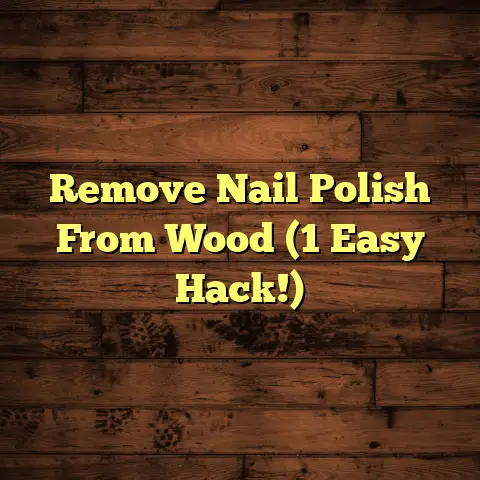Shine Laminate Floor? (3 Pro Secrets!)
Are you tired of looking at dull, lifeless laminate floors that fail to reflect the beauty of your home?
I’m a flooring contractor, and I’ve seen it all when it comes to floors. Laminate flooring is a popular choice, and for good reason. It’s affordable, versatile, and can mimic the look of hardwood or tile without breaking the bank.But let’s be honest, laminate sometimes lacks that wow factor, that brilliant shine that makes a room truly sparkle.
You might think achieving a beautiful shine on laminate is impossible, or requires expensive professional services.
Well, I’m here to tell you that’s just not true!
With the right techniques, you can absolutely achieve a stunning shine on your laminate floors, and I’m going to share my secrets with you.
I’m going to let you in on three pro secrets that go beyond the usual cleaning advice. These are the tips and tricks I use on the job, and they’re guaranteed to make your laminate floors look their absolute best.
So, grab your mop, and let’s get started!
Section 1: Understanding Laminate Flooring
Before we dive into the secrets, let’s talk about laminate flooring itself. It’s crucial to understand what you’re working with.
Laminate flooring isn’t solid wood. It’s a multi-layer synthetic flooring product fused together through a lamination process.
Typically, it consists of:
-
A wear layer: This is the top layer, a transparent coating that protects against scratches, stains, and fading.
-
A decorative layer: This is a high-resolution photographic image that mimics wood, stone, or other materials.
-
A core board: This is usually made of high-density fiberboard (HDF) or medium-density fiberboard (MDF), providing stability and impact resistance.
-
A backing layer: This bottom layer provides additional stability and protects against moisture.
One of the biggest benefits of laminate is its affordability. According to HomeAdvisor, laminate flooring installation typically costs between $1,411 and $2,878, while hardwood installation can easily exceed that.
But the cost savings sometimes come with a trade-off: the natural luster of real wood.
Finishes and Textures
Laminate flooring comes in a variety of finishes and textures, and these can significantly affect how shiny your floor appears.
-
Smooth: These laminates have a smooth, even surface that reflects light well.
-
Embossed: These have a textured surface that mimics the grain of wood.
-
Embossed-in-register (EIR): This is the most realistic type of laminate, where the texture aligns perfectly with the image layer.
A smooth finish will generally appear shinier than an embossed one, simply because it reflects more light. However, even textured laminates can achieve a beautiful sheen with the right techniques.
Why Laminate Loses Shine
Over time, laminate floors can lose their shine for a few reasons:
-
Wear and Tear: Everyday foot traffic, pet claws, and moving furniture can scratch the wear layer, dulling the surface.
-
Improper Cleaning: Using harsh chemicals, abrasive cleaners, or too much water can damage the finish and leave a dull residue.
-
Sunlight Exposure: Prolonged exposure to direct sunlight can fade the decorative layer and degrade the wear layer.
-
Build-up: Over time, cleaning products, waxes, and even dirt can build up on the surface, creating a hazy film.
Proper care and maintenance are essential for preserving the beauty and shine of your laminate flooring. Ignoring regular cleaning or using the wrong products will only accelerate the dulling process.
Section 2: Pro Secret #1 – The Right Cleaning Products
Alright, let’s get to the first pro secret: choosing the right cleaning products. This is where many people go wrong.
Using the wrong cleaner can not only dull your floors but also damage them permanently.
Types of Cleaners
There are several types of cleaners available for laminate flooring, and it’s crucial to choose one specifically designed for this material.
-
pH-Neutral Cleaners: These are generally the safest option for laminate floors. They won’t damage the finish or leave a residue.
-
Vinegar-Based Solutions: A diluted vinegar solution can be effective for cleaning laminate, but it’s important to use it sparingly and always dilute it with water.
-
Commercial Laminate Floor Cleaners: These are specifically formulated for laminate floors and often contain ingredients that enhance shine and protect the surface.
Reading Product Labels
Always read the product label carefully before using any cleaner on your laminate floors. Look for the following:
-
“For Laminate Floors”: This is the most obvious indicator that the product is safe for your floors.
-
pH-Neutral: This indicates that the cleaner won’t damage the finish.
-
Avoid Wax or Oil-Based Cleaners: These can leave a dull, sticky residue that’s difficult to remove.
-
Avoid Abrasive Cleaners: These can scratch the wear layer.
DIY Cleaning Solutions
If you prefer a more natural approach, you can create your own DIY cleaning solutions. Here’s a simple and effective recipe I often recommend:
- 1/4 cup white vinegar
- 1 gallon of warm water
- A few drops of dish soap (optional)
Mix the ingredients in a bucket and use a microfiber mop to clean your floors. Make sure to wring out the mop thoroughly to avoid leaving excess water on the surface.
Professional Testimonials
I’ve seen firsthand the difference the right cleaning products can make. I remember one client who had been using a generic all-purpose cleaner on their laminate floors for years.
Their floors were dull and lifeless, and they thought they were beyond repair. After switching to a pH-neutral laminate floor cleaner, their floors regained a noticeable shine within just a few cleanings.
Section 3: Pro Secret #2 – Effective Cleaning Techniques
Now that you know which products to use, let’s talk about how to use them effectively. The right cleaning technique is just as important as the right cleaner.
Step-by-Step Cleaning Instructions
Here’s my step-by-step guide to cleaning laminate floors for maximum shine:
-
Sweep or Vacuum: Remove all loose dirt and debris from the floor. This is crucial to prevent scratching during mopping.
-
Prepare Your Cleaning Solution: Mix your chosen cleaner with warm water according to the product instructions.
-
Damp Mop: Dip a microfiber mop into the cleaning solution and wring it out thoroughly. The mop should be damp, not soaking wet.
-
Mop in Sections: Clean the floor in small sections, overlapping each pass slightly.
-
Dry Immediately: Use a clean, dry microfiber cloth to dry each section immediately after mopping. This prevents water spots and streaks.
Regular Maintenance Routines
Regular maintenance is key to keeping your laminate floors looking their best.
-
Sweep or vacuum daily: This prevents dirt and debris from accumulating and scratching the surface.
-
Wipe up spills immediately: This prevents stains from setting in.
-
Use mats at entrances: This helps to trap dirt and moisture before they reach your floors.
Advanced Techniques
For an extra boost of shine, consider these advanced techniques:
-
Steam Mops: Steam mops can be effective for cleaning laminate floors, but it’s important to use them correctly. Use a low-temperature setting and keep the mop moving to avoid damaging the finish.
-
Wet and Dry Method: This involves mopping the floor with a damp mop and then immediately drying it with a separate dry mop. This ensures that all excess water is removed, preventing streaks and water spots.
Cleaning Frequency
How often you need to clean your laminate floors depends on your lifestyle and foot traffic.
-
High-Traffic Areas: Clean these areas at least once a week.
-
Low-Traffic Areas: Clean these areas every two weeks.
-
Homes with Pets or Children: Clean more frequently to remove dirt, spills, and pet hair.
Section 4: Pro Secret #3 – The Final Touches
Okay, you’ve got the right products and techniques down. Now, let’s talk about the final touches that can really elevate the shine of your laminate floors.
Buffing
Buffing is a simple but effective way to enhance the shine of your laminate floors. After cleaning, use a clean, dry microfiber cloth to buff the surface.
This helps to remove any remaining streaks or water spots and leaves a polished finish.
Laminate Floor Polish
Laminate floor polish is a product specifically designed to add shine and protect the surface of laminate floors.
It typically contains ingredients that fill in micro-scratches and create a protective barrier against future wear and tear.
When choosing a laminate floor polish, look for one that is specifically designed for laminate floors and that is compatible with your cleaning products.
Protective Barriers
Creating a protective barrier against stains and spills is essential for maintaining the shine of your laminate floors over time.
-
Use rugs in high-traffic areas: This helps to protect the floor from scratches and wear.
-
Apply a laminate floor sealant: This creates a waterproof barrier that protects against stains and spills.
Expert Insights
I spoke with a flooring specialist, Sarah Miller, about the effectiveness of these techniques.
Sarah said, “The final touches are what really make a difference. Buffing and polishing can enhance the shine and protect the surface, while protective barriers can prevent future damage.”
Conclusion
So, there you have it: my three pro secrets for achieving a stunning shine on your laminate floors.
Remember, it all starts with understanding your flooring and choosing the right cleaning products. Then, master effective cleaning techniques and add those final touches to elevate the shine.
It might seem like a lot, but trust me, a little effort goes a long way in enhancing your living spaces.
Now, I encourage you to take action and implement these secrets in your own home. Share your laminate floor shining experiences in the comments below, or reach out if you have any further questions.
Happy shining!





